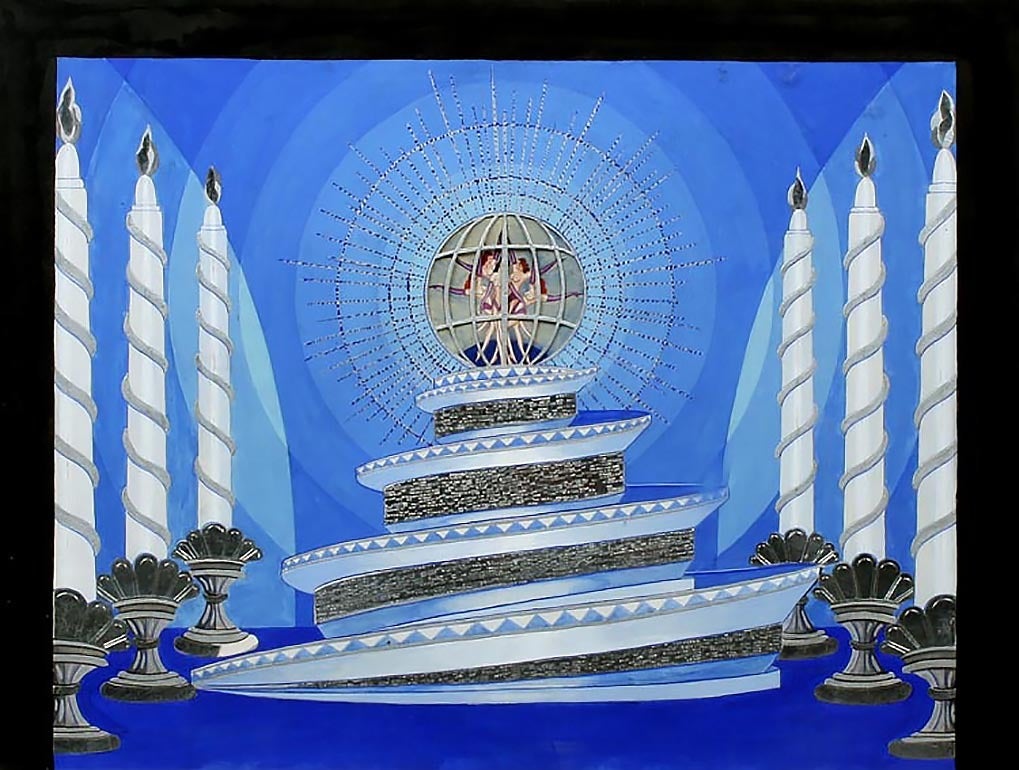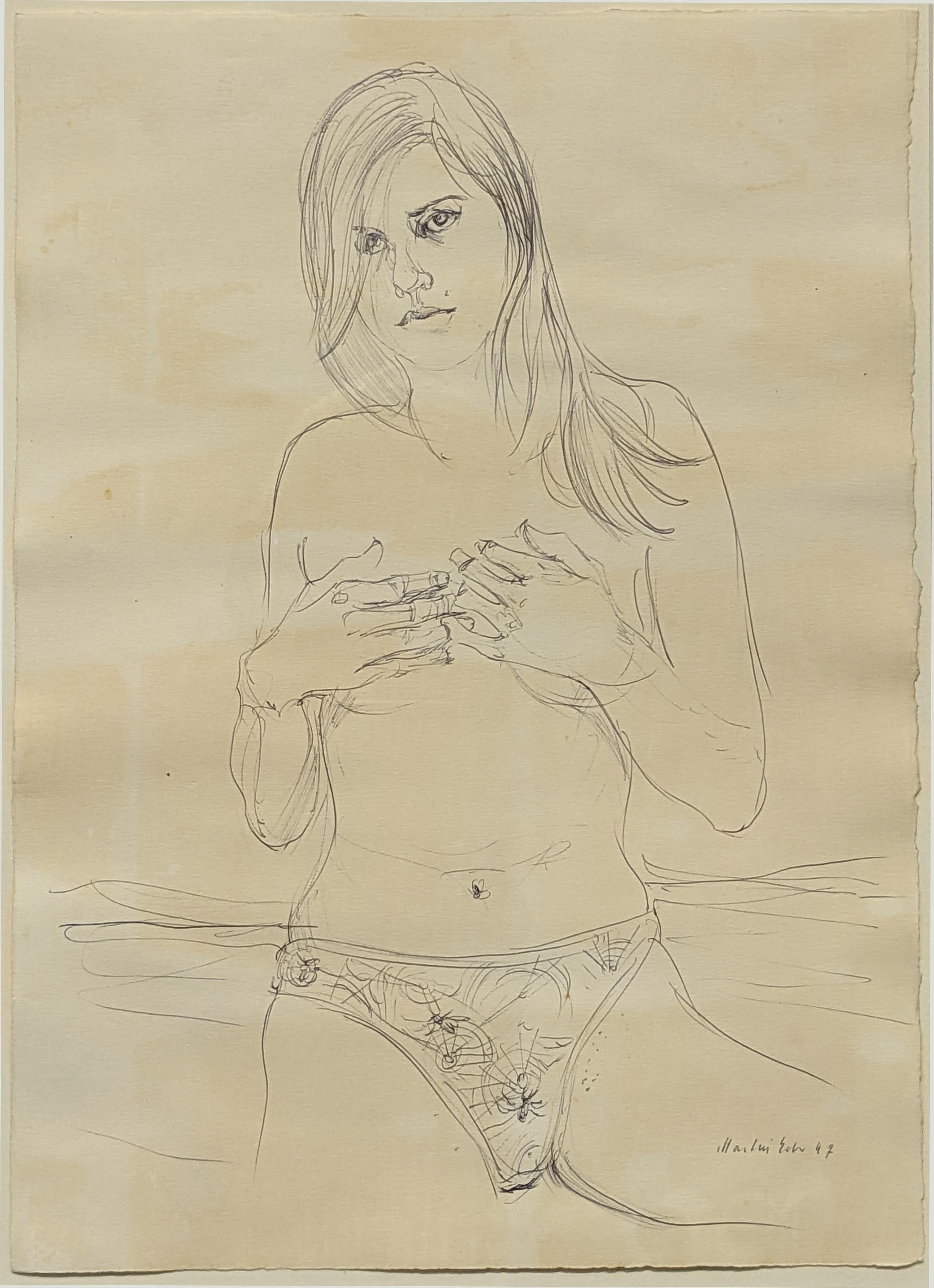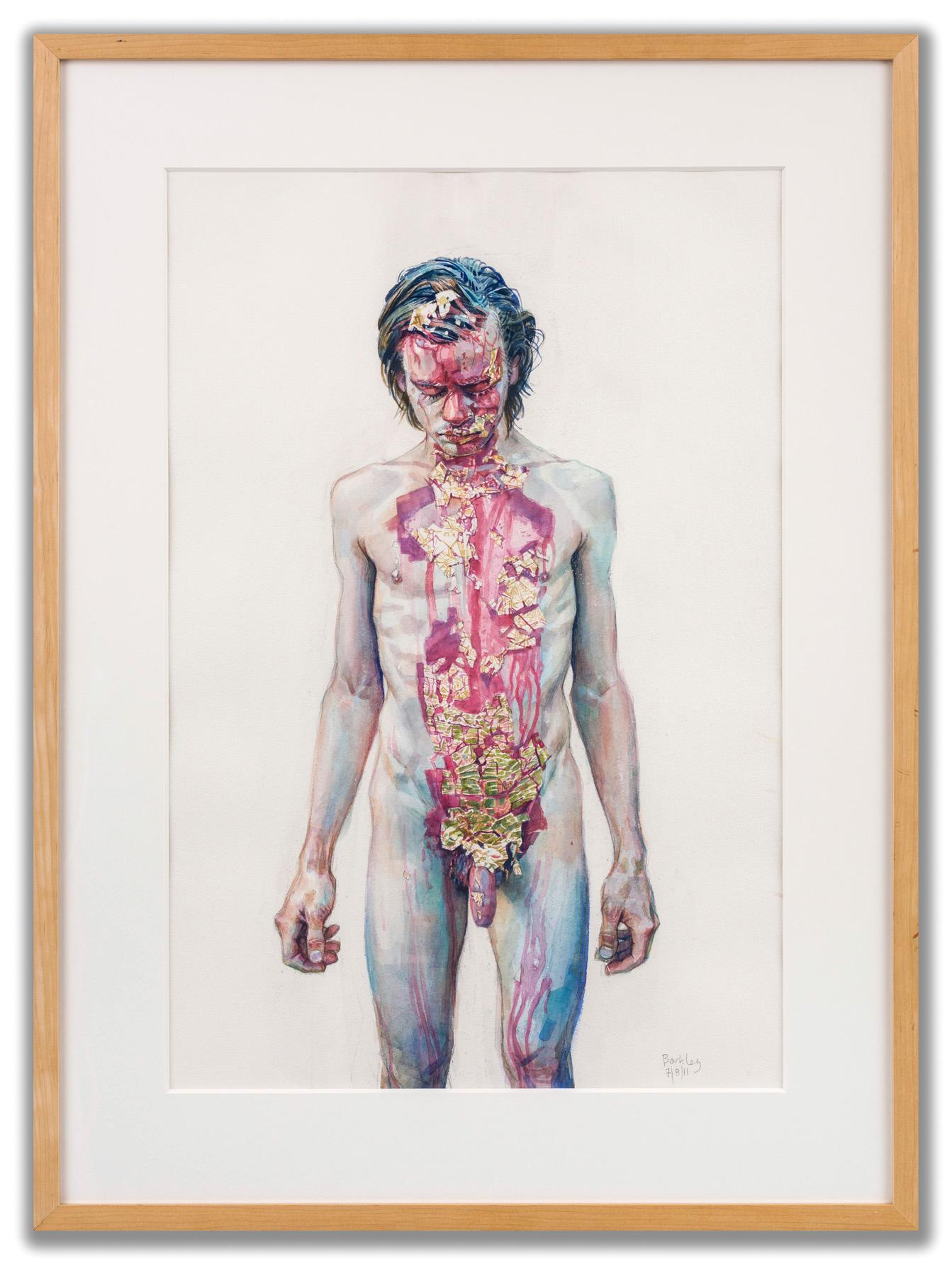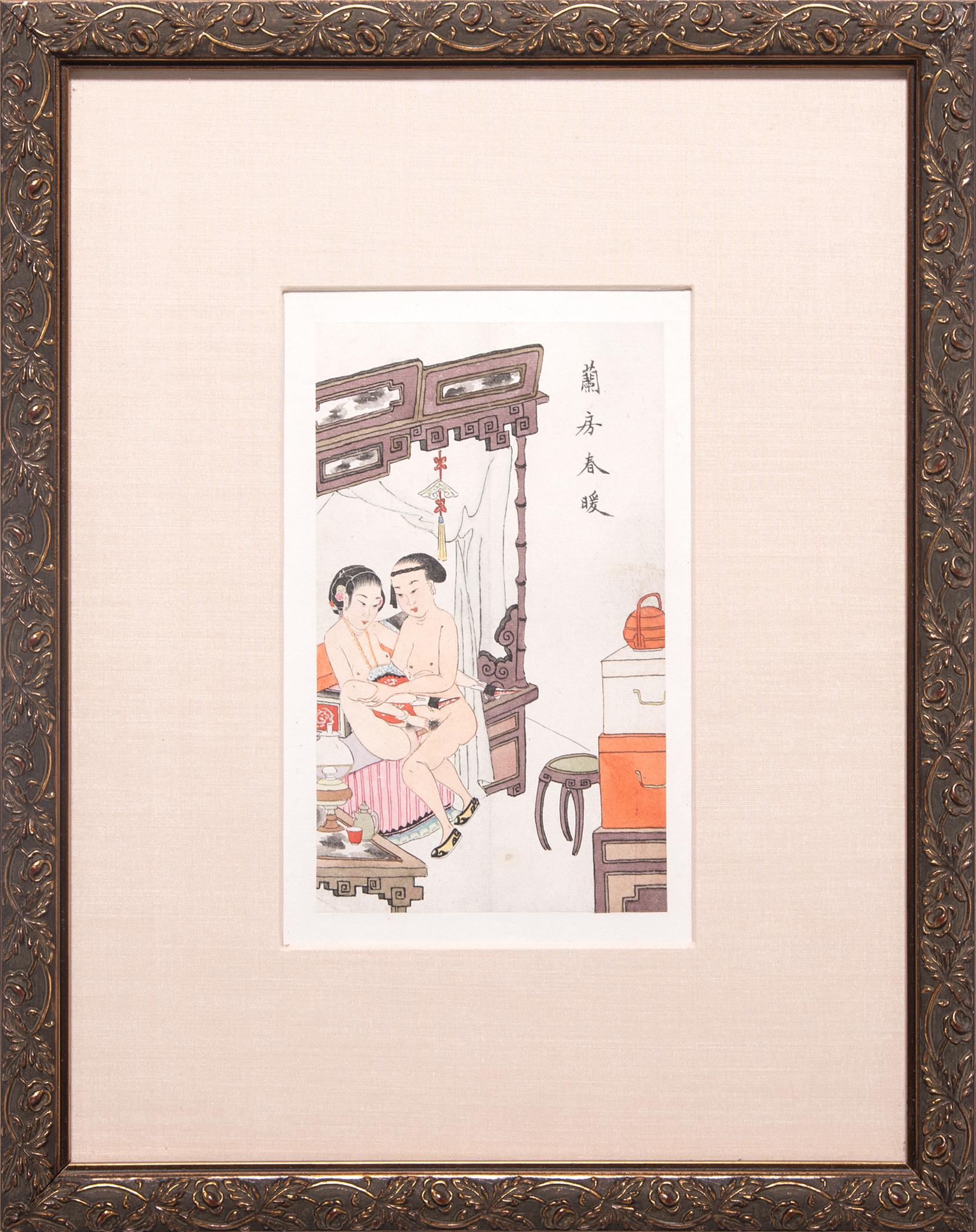Items Similar to Berthomme Saint-André, Before Bathing, 1926
Want more images or videos?
Request additional images or videos from the seller
1 of 9
Louis Berthomme Saint-AndreBerthomme Saint-André, Before Bathing, 19261926
1926
About the Item
Watercolor by Louis BERTHOMME SAINT-ANDRE, France, 1926. Befor bathing. With frame: 74x63.5 cm - 29.1x25 inches ; without frame, just the watercolor: 50x36 cm - 19.7x14.2 inches. Signed lower right "Be St André" (see photo). Named and dated on the back, studio stamp (see photo).
Louis Berthommé Saint-André is a figurative painter, fresco painter, decorator, illustrator, engraver, ceramist and French lithographer born in 1905. He comes from rural and commercial France: his father ran a wine and grocery business. In his youth, Louis Berthommé Saint-André was injured by a kick, which left him with a stiff leg, preventing him from driving, among other things. The family left Oise to settle in Saintes, where the artist studied at La Recouvrance. He entered as a student architect with Georges Naud, responsible for the historical monuments of Charente then, in 1921, he entered the School of Fine Arts in Paris.
Louis Berthommé Saint-André is one of the great representatives of French figurative painting in the 20th century. He was trained at the School of Fine Arts by two very old masters who died during his training: Fernand Cormon (1845-1924) and Jean-Paul Laurens (1838-1921). He retains from their training the taste for well-learned techniques, but from his first works, he is part of modernity. His constructions show decomposed forms inspired by Cézanne, while maintaining a keen sense of rigor. He never strayed from realism, but his very colorful, sometimes incisive palette and his freedom in representation gave his painting a bite and an acidity that placed Louis Berthommé Saint-André among the great talents of his time.
Silver medal at the Salon of French Artists where he exhibited from 1924 to 1929, he won the Abd-el-Tif Prize in 1925 and was then the youngest resident of the villa in Algiers. Friend of Jean Launois, in addition to his recognized portraits, he painted Algiers and the Kasbah. His studies of women recall those of Eugène Delacroix, but if his luminous inspiration is due to the Algerian sun, his touch is more Cézanne than purely orientalist. He left Algeria in 1928, to return there in 1931.
Before the war, Berthommé Saint-André exhibited regularly in all the major Salons: from 1928 at the Salon d'Automne, at the Salon des Beaux-Arts (1934 to 1936) at the Salon des Tuileries since 1935. His inspiration is close to surrealism .
During the Occupation, he became very "fauve", in reaction to the darkness of the war. He joined the Resistance, and collaborated with Vaincre (Resistance newspaper).
After the war, he developed a style close to poetic reality (Brianchon, Legueult, Oudot, Terechkovitch, Cavaillès. Caillard, Limouse, and Planson), without however ever being part of the group so called. He is present at the Salon Comparaison, at the Salon of painters Witnesses of our time, is president of the Salon of drawing and water-based painting. He has exhibited solo internationally, in Europe, the USA and Japan in particular. In 1977, he received just before his death, the grand prize of Painters Witnesses of their Time.
He died on October 1, 1977 in Paris.
Bibliography
- Michel Droit. Berthommé Saint-André. Éditions de la revue moderne, 1981
Wall frescoes
Entrance to the Direction, National School of Fine Arts, Paris
Lycée Charlemagne, Paris, Notre-Dame and the banks of the Seine, 1952
Staircase of the Faculty of Poitiers
Personal exhibitions
Villa Abd-el-Tif, Alger, 1922
Galerie Armand Drouant, Paris, 1928
Galerie Marcel Bernheim, Paris, 1937
Galerie Barreiro, Paris, 1937
Galerie Colinne, Oran, 1950
Musée des beaux-arts, Poitiers, 1952
Galerie Chardin, Paris, octobre 1958
Collective exhibitions
Salon des artistes français, Paris, de 1924 à 1929
Artistes algériens et orientalistes, Alger, 1927
Salon d'automne, Paris, à partir de 1928
Salon de la Société nationale des beaux-arts, Paris, 1934, 1935, 1936
Salon des Tuileries, Paris, à partir de 1935
Bimillénaire de Paris - Comité Montparnasse - Exposition de peintres et sculpteurs de l'École de Paris, La Coupole, Paris, juin-juillet 1951
Salon des peintres témoins de leur temps, 1956, 1976 (toile présentée : Les ostréiculteurs)7, 1977 (toile présentée :Fête dans la clairière)
Salon Comparaisons, Paris, à partir de 1956
Première exposition internationale des arts de Téhéran, Centre des expositions internationales, Téhéran, décembre 1974 - janvier 1975
- Creator:Louis Berthomme Saint-Andre (1905-1977, French)
- Creation Year:1926
- Dimensions:Height: 25.01 in (63.5 cm)Width: 29.14 in (74 cm)Depth: 1.58 in (4 cm)
- Medium:
- Movement & Style:
- Period:
- Condition:
- Gallery Location:Saint Amans des cots, FR
- Reference Number:1stDibs: LU1088213821772
About the Seller
5.0
Vetted Seller
These experienced sellers undergo a comprehensive evaluation by our team of in-house experts.
1stDibs seller since 2018
34 sales on 1stDibs
- ShippingRetrieving quote...Ships From: Saint Amans des cots, France
- Return PolicyA return for this item may be initiated within 2 days of delivery.
More From This SellerView All
- "Boating on the Morin River"By André Dunoyer de SegonzacLocated in Saint Amans des cots, FRPen, ink, watercolor and wash on paper by André Dunoyer de Segonzac, France, 1922-1924. Boating on the Morin River. Measurements : with frame: 52.5x65x2 cm - 20.7x25.6x0.8 inches / without frame: 36.5x45 cm - 14.4x17.7 inches. Signed lower left "A. Dunoyer de Segonzac". Colors may vary slightly depending on your screen. The lighter band at the top and the bottom of the piece, visible in the first picture, is only due to the reflection in the protective glass. It does not exist. In its frame gilt with gold leaf and its protective glass. André Dunoyer de Segonzac was born in Boussy-Saint-Antoine (Essonne) July 7, 1884. After his schooling at high school Henri IV, as early as 1900, he attends classes at the National School of Fine Arts in Paris in free listener where he will befriend Charles Dufresne. In 1903, he enters the private studio of Luc-Olivier Merson. In 1907, he studies with Jean-Paul Laurens and attends the La Palette and Colarossi academies in Montparnasse. He meets Luc-Albert Moreau and Jean-Louis Boussingault with whom he shares a studio. His first drawings are published in 1908 in The Great Review and The Witness. Nearly indifferent to contemporary aesthetic revolutions, Dunoyer de Segonzac undertakes, with Jean-Louis Boussingault and Luc-Albert Moreau, to revive Gustave Courbet's realism by performing still lifes, nudes, landscapes, in a thick paste and masonry . In one of his letters to the painter Maurice Boitel, he wrote in the 1950s: "I have not forgotten the heroic period of the independents - when we were grouped around Paul Signac, the charming and valiant Maximilien Luce - in these barracks where the living and authentic Art was grouped outside the academic formulas - or literary and systematic tendencies - which were to lead to this abstract aesthetic of which the painting dies. " In 1908, he begins exhibiting at the Salon d'Automne and the Salon des Indépendants, with Paul Signac and Maximilien Luce. He befriends Apollinaire, Max Jacob, Raoul Dufy and Vlaminck. From this period, renting a house belonging to Signac, Dunoyer discovers the landscapes of Saint-Tropez, to which he will remain faithful and where he lived until the end of his life. He stays in Saint-Tropez only in the summer season. For the rest, he leads a real nomadic life, in search of the motive especially through the Île-de-France, the Grand Morin valley, Feucherolles, Chennevières-sur-Marne, Guyancourt, etc. "I also worked a lot on the banks of the Seine in Chatou, Bougival, Andrésy, Poissy and Triel that I particularly like, with its beautiful Gothic church that is reflected in the Seine and the high wooded hills that surround him", he will say. In 1910, he knows fashion designer Paul Poiret and meets Max Jacob, Raoul Dufy and Vlaminck. From 1910 to 1914, he travels to Italy, Spain, North Africa, and is interested in sport and dance (drawings of Isadora Duncan's Russian Ballets, 1911, The Boxers1910). From 1914 to 1918, mobilized in the infantry, he makes the war hardly, before being assigned to camouflage. He performs many war drawings, valuable for their artistic and documentary value. From 1919, he appears again in many exhibitions, including major Parisian salons. Nearly indifferent to contemporary aesthetic revolutions, Dunoyer de Segonzac undertakes, with Boussingault and Moreau, to revive Courbet's realism by performing still lifes, nudes, landscapes, in a thick and masonry paste. Enlisted in engraving by Jean Émile Laboureur, he makes nearly 1,600 brass plaques from 1919 to 1970. He was president of the Society of French painters-engravers. In 1921, he meets Paul Valéry, Léon-Paul Fargue and Jean Cocteau. In 1928, he makes a trip to America where he met with great success. In 1930, he becomes friend with Derain. In 1933 he receiveds the Carnegie Foundation of Pittsburgh Award and in 1934 the Venice Biennale. During the Occupation, in November 1941, he takes part in a "study trip" to Germany, organized by Arno Breker, accepting, like other artists of the most renowned, to visit the hotspots of German culture as well as artist workshops. After the war, he is exhibited in the best galleries...Category
1920s Realist Figurative Drawings and Watercolors
MaterialsPaper, Ink, Watercolor, Pen
- Berthomme Saint-André, The Nap, Watercolor, 1925By Louis Berthomme Saint-AndreLocated in Saint Amans des cots, FRWatercolor by Louis BERTHOMME SAINT-ANDRE, France, ca.1925. The nap. With frame: 75x60.5 cm - 29.5x23.8 inches, without frame, just the watercolor: 53x39 cm - 20.9x15.35 inches. Signed lower left "Berthomme St André" (see photo). Louis Berthommé Saint-André is a figurative painter, fresco painter, decorator, illustrator, engraver, ceramist and French lithographer born in 1905. He comes from rural and commercial France: his father ran a wine and grocery business. In his youth, Louis Berthommé Saint-André was injured by a kick, which left him with a stiff leg, preventing him from driving, among other things. The family left Oise to settle in Saintes, where the artist studied at La Recouvrance. He entered as a student architect with Georges Naud, responsible for the historical monuments of Charente then, in 1921, he entered the School of Fine Arts in Paris. Louis Berthommé Saint-André is one of the great representatives of French figurative painting in the 20th century. He was trained at the School of Fine Arts by two very old masters who died during his training: Fernand Cormon (1845-1924) and Jean-Paul Laurens (1838-1921). He retains from their training the taste for well-learnt techniques, but from his first works, he is part of modernity. His constructions show decomposed forms inspired by Cézanne, while maintaining a keen sense of rigour. He never strayed from realism, but his very colourful, sometimes incisive palette and his freedom in representation gave his painting a bite and an acidity that placed Louis Berthommé Saint-André among the great talents of his time. Silver medal at the Salon of French Artists where he exhibited from 1924 to 1929, he won the Abd-el-Tif Prise in 1925 and was then the youngest resident of the villa in Algiers. Friend of Jean Launois, in addition to his recognised portraits, he painted Algiers and the Kasbah. His studies of women recall those of Eugène Delacroix, but if his luminous inspiration is due to the Algerian sun, his touch is more Cézanne than purely orientalist. He left Algeria in 1928, to return there in 1931. Before the war, Berthommé Saint-André exhibited regularly in all the major Salons: from 1928 at the Salon d'Automne, at the Salon des Beaux-Arts (1934 to 1936) at the Salon des Tuileries since 1935. His inspiration is close to surrealism . During the Occupation, he became very "fauve", in reaction to the darkness of the war. He joined the Resistance, and collaborated with Vaincre (Resistance newspaper). After the war, he developed a style close to poetic reality (Brianchon, Legueult, Oudot, Terechkovitch, Cavaillès. Caillard, Limouse, and Planson), without however ever being part of the group so called. He is present at the Salon Comparaison, at the Salon of painters Witnesses of our time, is president of the Salon of drawing and water-based painting. He has exhibited solo internationally, in Europe, the USA and Japan in particular. In 1977, he received just before his death, the grand prise of Painters Witnesses of their Time. He died on October 1, 1977 in Paris. Bibliography - Michel Droit. Berthommé Saint-André. Éditions de la revue moderne, 1981 Wall frescoes Entrance to the Direction, National School of Fine Arts, Paris Lycée Charlemagne, Paris, Notre-Dame and the banks of the Seine, 1952 Staircase of the Staff of Poitiers Personal exhibitions Villa Abd-el-Tif, Alger, 1922 Galerie Armand Drouant, Paris, 1928 Galerie Marcel Bernheim...Category
1920s Post-Impressionist Nude Drawings and Watercolors
MaterialsPaper, Watercolor
- Henri Rapin, Gouache on Paper "Fructidor", 1924-1928Located in Saint Amans des cots, FRThis gouache is a museal and historical piece. Gouache and charcoal on paper stuck on panel by Henri Rapin, France, 1924-1928. "Fructidor". With frame: 80x114x3 cm - 31.5x44.9x1.2, w...Category
1920s Art Deco Figurative Drawings and Watercolors
MaterialsPaper, Gouache
- Deschmacker, Young Woman Lying By The Sea, WatercolorBy Paul Alex DeschmackerLocated in Saint Amans des cots, FRWatercolor by Paul-Alex Deschmacker, France, 1920s. This watercolor is in the classical period populated by mythological characters of Paul-Alex Deschmacker, itself becoming part of ...Category
1920s Art Deco Figurative Drawings and Watercolors
MaterialsWatercolor
- Madeleine RENAUD, Watercolor, The Wreath Of CarnationsLocated in Saint Amans des cots, FRWatercolor by Madeleine RENAUD (1900-1994), France. Wreath of Carnations. With frame: 60.2x89 cm - 23.7x35 inches without frame: 73x43 cm - 28.7x16.9 inches. Signed "Madeleine Renaud...Category
20th Century Impressionist Figurative Drawings and Watercolors
MaterialsWatercolor
- James Ward The Fisherman's FamilyBy James WardLocated in Saint Amans des cots, FRPrecious Watercolor attributed to James WARD (1769-1859) - England, 1830-1840. The Fisherman' S Family. Measurements : View : 20"x14.6" (51x37 cm), With frame : 26.6"x21.5" (67.5x54....Category
1830s Romantic Figurative Drawings and Watercolors
MaterialsPaper, Watercolor
You May Also Like
- The Birthday CakeBy Anthony NelleLocated in Buffalo, NYAn Art Deco gouache painting by American artist Anthony Nelle featuring exquisite details and materials to create a fantastic and enchanting scene.Category
1920s Art Deco Figurative Drawings and Watercolors
MaterialsSilver Leaf
- Original Art deco gouache and ink drawing of Jane Marnac in a hat by Gesmar 1921By Charles GesmarLocated in Petworth, West SussexCharles Gesmar (French, 1900 - 1928) Portrait of Jane Marnac, 1921 Gouache and ink on paper with some watercolour Signed ‘C. Gesmar. 21’ (upper left) 18 x 18 in. (45.8 x 45.8 cm.) Gesmar had a very short but successful artistic career prior to his tragic death from pneumonia. He designed for Mistinguett, creating costumes as well as many other commissions for the theatres of the day in Paris. He worked with posters and is thought of as a talent equal to Leon Bakst, his graphic designs linking the works of Toulouse Lautrec and Rene Grau...Category
Early 20th Century Art Deco Nude Drawings and Watercolors
MaterialsPaper, Ink, Watercolor, Gouache
- untitled / ohne TitelBy Martin EderLocated in New York, NYMartin Eder untitled work on paper executed in ballpoint pen with traces of watercolor. Ohne Titel Arbeit auf Papier, ausgeführt in Kugelschreiber mit Spuren von Aquarell. 2007Category
Early 2000s Realist Nude Drawings and Watercolors
MaterialsInk, Watercolor, Pen
- Study for Fallen Angel IIIBy Daniel BarkleyLocated in London, GBWatercolour, signed and dated (lower right), 76cm x 56cm, (93cm x 69cm framed). Daniel Barkley is known for his nude figurative work alluding to myths, legends and art history, whi...Category
2010s Modern Figurative Drawings and Watercolors
MaterialsWatercolor, Paper
- Standing Female Nude watercolor by Philadelphia Artist Adolphe BorieLocated in Philadelphia, PAADOLPHE BORIE (American, 1877-1934) Standing Female Nude Wash & charcoal on gray laid paper, 12 x 9 inches Framed: 16 x 13 inches Estate stamp lower right Born in Philadelphia, Adol...Category
Early 20th Century Modern Figurative Drawings and Watercolors
MaterialsCharcoal, Paper, Watercolor
- Chinese Erotic Album Leaf, c. 1850Located in Chicago, ILDespite its explicit content, this intimate scene conveys a sense of tenderness and romantic love characteristic of Chinese erotic art. Known as “sp...Category
Mid-19th Century Qing Figurative Drawings and Watercolors
MaterialsPaper, Ink, Watercolor
Recently Viewed
View AllMore Ways To Browse
Andy Warhol Howdy Doody
Bill Reilly
Chanel Bottle Poster
Eduardo Manet
Enrique Alvarez
Historic Palestine Banksy
Invader 3d Little Big Space
Jaque Marie
Amal Dagher
Armando Pizzinato
Bahama Rum
Cowboy With Dog Black And White
Davis Ginko
Joaquin Bastida
Olaf Olson
Sillon Individual
Alois Kronschlaeger
Andy Warhol Green Cat





